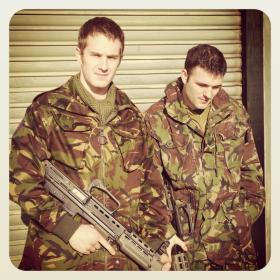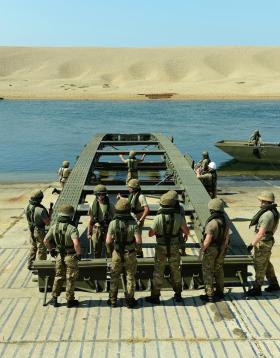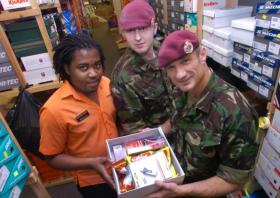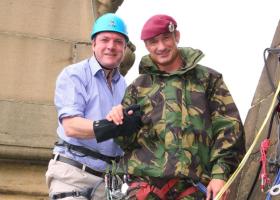
299 Parachute Squadron, RE, (TA)
299 Parachute Squadron, RE, (TA)
299 Parachute Squadron is an Army Reserve unit which forms part of 23 Parachute Engineer Regiment and is located in the north east of England.
It is the only Territorial Army parachute trained Royal Engineer squadron and recruits from a wide radius, centred on their barracks in Hull, Wakefield and Gateshead.
299 Airborne Field Squadron RE (TA) was formed in 1947 when the Territorial Army was reformed, as part of 131 Airborne Engineer Regiment (TA). The regiment provided engineer support for 16 Airborne Division (TA), which consisted of three brigades - 44, 45 and 46 Parachute Brigades (TA). In addition to 299 Squadron, 131 Regiment also consisted of 300, 301 and 302 Airborne Field Squadrons and Regimental Headquarters (RHQ).
The first Officer Commanding The Squadron was Major George Widdowson, TD, who served with the 1st Airborne Division in North Africa, Italy and Arnhem. Headquarters was at the Royal Engineers Drill Hall, Corporation Field, Park Street, Hull.
The Squadron was established for 13 officers and 251 other ranks. Initially persons eligible to join had to be either qualified parachutists or tradesmen.
Over the next few years The Squadron and Regiment were progressively geographically reorganised until by 1954, 299 Squadron consisted of Headquarters and 1 Troop in Hull, with Field Troops in Liverpool and Doncaster.
In 1956 16 Airborne Division (TA) was reduced in size to become 44 Independent Parachute Brigade Group (TA) (consisting of four Parachute Regiment battalions). 131 Regiment was retained complete and was renamed 131 Parachute Engineer Regiment (TA) with 299 becoming 299 Parachute Field Squadron RE (TA), the other Squadron's being similarly renamed.
The Regiment reached it's peak in the early 1960s when it fielded over 1000 volunteers.
In 1965 the bulk of The Regiment went to Annual Camp in Aden (now South Yemen) to work on the Dhala Road construction project. It was during this time that WO2 (SSM) John Lonergan of 300 Parachute Field Squadron was killed in action during an attack by dissidents, with two other 300 Squadron soldiers wounded.
The Regimental Doctor, Major Clive Samuel, was awarded an MBE for attending casualties in the open. It is in honour of the men involved in this incident that Aden Troop of today's 299 Para Squadron is named.
In 1967, in the second major reduction and post-war reorganisation of the TA, 44 Independent Parachute Brigade Group (TA) was reduced in size to three Parachute Regiment Battalions, a Royal Artillery Battery and a Royal Engineer Squadron.
131 Parachute Engineer Regiment (TA) was reduced in size to become 131 Independent Parachute Squadron RE (V) and the squadrons which made up the regiment were correspondingly reduced to become the Troops of the new squadron. Headquarters and Support Troops were based at Kingsbury, with the three Parachute Field Troops inheriting the numbers and locations of the squadrons that had been their predecessors. Thus 299 Parachute Field Squadron RE (TA) became 299 Parachute Field Troop, based at the former squadron location in Hull.
In 1977 reductions in Regular and Territorial Airborne Forces were announced and on 31 March 1978, 44 Independent Parachute Brigade Group (TA) was disbanded after a parade at Altcar Ranges.
131 Independent Parachute Squadron's uncertain future was assured when on the 1st April 1978 it was accepted onto the order of battle of 3 Commando Brigade, Royal Marines, as 131 Independent Commando Squadron RE (V).
299 Parachute Field Troop became 299 Troop of the renamed squadron. 131 became the only TA unit on the order of battle of a regular brigade. In order to wear the green beret of commando forces every soldier who wished to remain with The Squadron in it's new role had to pass the Commando Tests and in July 1978 a specially run Airborne Engineers Commando Conversion Course was undertaken as annual camp for that year. The Squadron retained an official parachute capability with the support of 3 Commando Brigade.
In the following years 299 Troop members became proficient in arctic and jungle warfare in addition to parachuting and engineer training. Changes in the way TA soldiers could be employed, with the introduction of the Reserve Forces Act of 1996 led to 299 Troop Sappers deploying more widely with the Regular Army including to Cyprus with the UN and on the worldwide Exercise Ocean Wave in the late 1990s.
In January 2003, 299 Troop was mobilised, along with the rest of 131 Independent Commando Squadron, for service on Operation TELIC, the forthcoming Invasion of Iraq. In the hours of darkness before 'H Hour', 299 Troop were busy clearing mines and other obstacles from 'Red Beach' in advance of a beach assault by the United States Marine Corps (USMC).
Later, 299 Troop achieved an operational first by constructing the first Medium Girder Bridge (MGB) to be flown into position.
A further restructuring of the Territorial Army called for the creation of a parachute trained Royal Engineer Squadron and on 6th June 2006, 299 Parachute Squadron RE (V) was officially reformed at a parade held at the new Squadron Headquarters in Wakefield. The new Squadron Colours were raised by Norman Sangwin (pictured) - one of the few surviving members of the original 299 Airborne Field Squadron RE (TA).
This new squadron was based on 299 Troop of 131 Commando Squadron RE (V), who became 1 Troop, and Minden Company, Light Infantry, whose Headquarters at George Street TA Centre was taken over as Headquarters of the reborn 299 Para Squadron, this being the location of HQ and 2 Troops. A third field troop, 3 Troop, was raised in Gateshead in 2009. The Squadron became part of the reformed 72 Engineer Regiment (V).
Despite becoming part of the new 299 Para Squadron, 1 Troop still had an outstanding commitment to fulfil to 131 Independent Commando Squadron and the majority of the troop were mobilised for service in Afghanistan on Operation HERRICK V over the winter of 2006/7. The Sappers used their skills to provide close engineering support for 3 Commando Brigade all over Helmand Province. Since then 299 Parachute Squadron soldiers have deployed on Operation Herrick in Helmand Province, Afghanistan in 2006, 2007, 2008 and 2009, serving as part of 16 Air Assault Brigade, 3 Commando Brigade and 19 Light Brigade.
In 2010 299 Para Sqn RE was re-subordinated under 23 Engineer Regiment (Air Assault) which was renamed as 23 Parachute Engineer Regiment in 2015.
Read MoreNewsletter Signup
Donate
Make a donation to Airborne Assault ParaData to help preserve the history of The Parachute Regiment and Airborne Forces
The Airborne Shop
The Airborne Shop is the official shop of Support Our Paras (The Parachute Regiment Charity RCN1131977).
Profits from all sales made through our shop go directly to Support Our Paras, so every purchase you make with us will directly benefit The Parachute Regiment and Airborne Forces.





Latest Comments
There are currently no comments for this content.
Add Comment
In order to add comments you must be registered with ParaData.
If you are currently a ParaData member please login.
If you are not currently a ParaData member but wish to get involved please register.